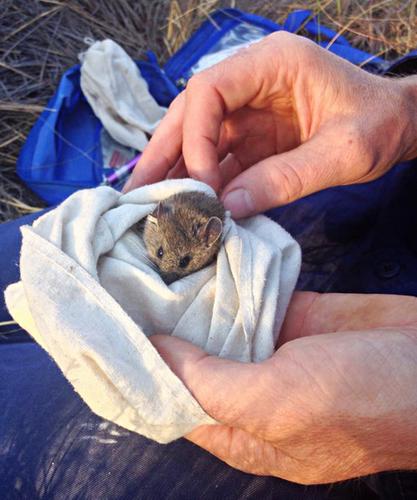当前位置:
X-MOL 学术
›
Anim. Conserv.
›
论文详情
Our official English website, www.x-mol.net, welcomes your feedback! (Note: you will need to create a separate account there.)
Habitat selection and genetic diversity of a reintroduced ‘refugee species’
Animal Conservation ( IF 3.4 ) Pub Date : 2019-11-27 , DOI: 10.1111/acv.12550 K. Abicair 1 , A. D. Manning 1 , F. Ford 2 , J. Newport 1 , S. C. Banks 1
Animal Conservation ( IF 3.4 ) Pub Date : 2019-11-27 , DOI: 10.1111/acv.12550 K. Abicair 1 , A. D. Manning 1 , F. Ford 2 , J. Newport 1 , S. C. Banks 1
Affiliation

|
A ‘refugee’ species is one with a current distribution that has been restricted to a subset of their former niche by threatening processes. Conservation opportunities for such species can be limited by a poor understanding of habitat requirements, where habitat models are based on current distributions and not the innate capacity of the animal to survive where threats are managed. We examined patterns of habitat selection by a putative refugee species, the threatened New Holland mouse Pseudomys novaehollandiae, following reintroduction into historic habitat (habitat that corresponds to a currently unoccupied component of its former niche). Current New Holland mouse populations exist predominantly in coastal heath habitat of select vegetation and fire history, and these environmental conditions differ greatly to those found across the species historical distribution. Using a novel, non‐invasive method of detection for the species, we investigated patterns of habitat selection following reintroduction into historic habitat, where the species primary threat of exotic predators has been removed. We also assessed the changes in genetic diversity measures across three stages of the reintroduction process (before, during and after) using microsatellite markers, to reflect on past efforts in maintaining genetic diversity. We found that historic habitat can still support New Holland mouse populations and identified more diverse potential habitat for the species. We also identified loss of alleles and an increased inbreeding coefficient at the captive breeding stage, but these findings were not statistically significant. This study expands on our limited understanding of habitat requirements and the fundamental niche of the New Holland mouse, highlighting new potential conservation opportunities.
中文翻译:

重新引入的“难民物种”的栖息地选择和遗传多样性
“难民”物种是当前分布因威胁过程而被限制在其前生态位的一个子集的物种。由于对栖息地要求的理解不足,对此类物种的保护机会可能会受到限制,其中栖息地模型基于当前的分布,而不是动物在应对威胁的情况下生存的先天能力。我们研究了一种推定的难民物种,即受威胁的新荷兰鼠 Pseudomys novaehollandiae,在重新引入历史栖息地(栖息地与其前生态位中目前无人居住的部分相对应)的栖息地选择模式。目前的新荷兰小鼠种群主要存在于特定植被和火灾历史的沿海荒地栖息地,这些环境条件与物种历史分布中发现的环境条件大不相同。我们使用一种新颖的、非侵入性的物种检测方法,研究了重新引入历史栖息地后的栖息地选择模式,在那里,外来掠食者的物种主要威胁已被消除。我们还使用微卫星标记评估了重新引入过程的三个阶段(之前、之中和之后)遗传多样性测量的变化,以反映过去在维持遗传多样性方面的努力。我们发现历史栖息地仍然可以支持新荷兰小鼠种群,并为该物种确定了更多样化的潜在栖息地。我们还发现在圈养繁殖阶段等位基因丢失和近亲繁殖系数增加,但这些发现在统计上并不显着。这项研究扩展了我们对栖息地要求和新荷兰老鼠的基本生态位的有限理解,突出了新的潜在保护机会。
更新日期:2019-11-27
中文翻译:

重新引入的“难民物种”的栖息地选择和遗传多样性
“难民”物种是当前分布因威胁过程而被限制在其前生态位的一个子集的物种。由于对栖息地要求的理解不足,对此类物种的保护机会可能会受到限制,其中栖息地模型基于当前的分布,而不是动物在应对威胁的情况下生存的先天能力。我们研究了一种推定的难民物种,即受威胁的新荷兰鼠 Pseudomys novaehollandiae,在重新引入历史栖息地(栖息地与其前生态位中目前无人居住的部分相对应)的栖息地选择模式。目前的新荷兰小鼠种群主要存在于特定植被和火灾历史的沿海荒地栖息地,这些环境条件与物种历史分布中发现的环境条件大不相同。我们使用一种新颖的、非侵入性的物种检测方法,研究了重新引入历史栖息地后的栖息地选择模式,在那里,外来掠食者的物种主要威胁已被消除。我们还使用微卫星标记评估了重新引入过程的三个阶段(之前、之中和之后)遗传多样性测量的变化,以反映过去在维持遗传多样性方面的努力。我们发现历史栖息地仍然可以支持新荷兰小鼠种群,并为该物种确定了更多样化的潜在栖息地。我们还发现在圈养繁殖阶段等位基因丢失和近亲繁殖系数增加,但这些发现在统计上并不显着。这项研究扩展了我们对栖息地要求和新荷兰老鼠的基本生态位的有限理解,突出了新的潜在保护机会。


























 京公网安备 11010802027423号
京公网安备 11010802027423号